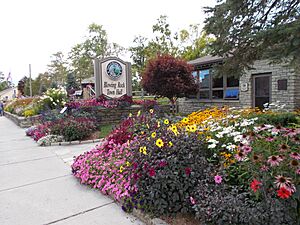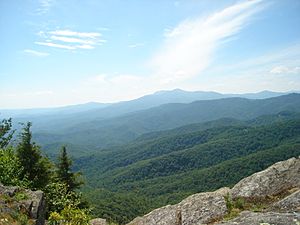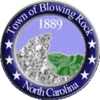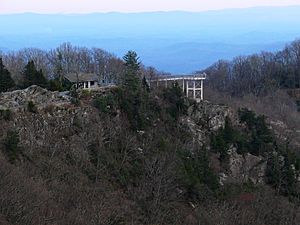Blowing Rock, North Carolina facts for kids
Quick facts for kids
Blowing Rock, North Carolina
|
|||
|---|---|---|---|
|
Town
|
|||

Town hall
|
|||
|
|||
| Nickname(s):
The Crown of the Blue Ridge
|
|||

Location of Blowing Rock, North Carolina
|
|||
| Country | United States | ||
| State | North Carolina | ||
| Counties | Watauga, Caldwell | ||
| Government | |||
| • Type | Council-Manager | ||
| Area | |||
| • Total | 3.29 sq mi (8.51 km2) | ||
| • Land | 3.24 sq mi (8.40 km2) | ||
| • Water | 0.04 sq mi (0.11 km2) | ||
| Elevation | 3,517 ft (1,072 m) | ||
| Population
(2020)
|
|||
| • Total | 1,376 | ||
| • Density | 424.43/sq mi (163.88/km2) | ||
| Time zone | UTC-5 (Eastern (EST)) | ||
| • Summer (DST) | UTC-4 (EDT) | ||
| ZIP code |
28605
|
||
| Area code(s) | 828 | ||
| FIPS code | 37-06500 | ||
| GNIS feature ID | 2405281 | ||
Blowing Rock is a town in North Carolina, United States. It's located in both Watauga and Caldwell counties. In 2021, about 1,397 people lived there.
Contents
A Look at Blowing Rock's Past
Before 1752, the windy cliffs of the Blowing Rock area were home to the Cherokee and Catawba Native American tribes.
Early Settlers and the Civil War
After the mid-1700s, Scots-Irish pioneers began to settle in this mountain region. Many colonists, farmers, and hunters traveled through the mountain passes. The first family to settle in Blowing Rock was the Greenes. They arrived by the mid-1800s. Their settlement was on the land where the Green Park Hotel now stands.
Other early families included the Hayes, Coffey, Bolick, Estes, and Storie families. During the American Civil War, North Carolina's mountains saw fighting. To keep their families safe, men joining the Confederate Army often sent them to Blowing Rock. It became a safe place away from the battles.
Becoming a Tourist Town
After the Civil War, many veterans joined their families and stayed in Blowing Rock. At the same time, people from nearby Lenoir started visiting in the summer. They loved the cool air and amazing mountain views. The residents saw that their village could become a popular spot for wealthy tourists.
So, on March 11, 1889, Blowing Rock officially became a town. Its first mayor was "Uncle" Joe Clarke. The town started with about 300 people.
As more people heard about Blowing Rock, more visitors arrived. They first camped, then stayed in boarding houses. Soon, there were too many visitors for the existing places. Many homes were turned into hotels. The first hotel, the Watauga Hotel, opened in 1884. The Green Park Hotel opened in 1891, and the Blowing Rock Hotel followed in 1899.
Modernizing for Visitors
As tourism grew, the town had to change. Streets were mostly dirt paths, so they needed paving. Another problem was farm animals wandering into town. In 1896, the town passed a rule requiring farmers to fence in their animals.
In the early 1900s, cars and better roads made it easier to reach Blowing Rock. Visitors started coming from far away, even Florida. Today, Blowing Rock is still a popular tourist spot for people across the United States. The town works to protect its historic buildings and keep its small-town charm. This charm has attracted many people for over 150 years.
Historic Places to See
Many buildings in Blowing Rock are listed on the National Register of Historic Places. These include the Green Park Inn, the Bollinger-Hartley House, and Moses Cone's Flat Top Manor. These places show the town's rich history.
Where is Blowing Rock Located?


Blowing Rock is in the southern part of Watauga County, within the Blue Ridge Mountains. A small part of the town, including the famous Blowing Rock cliff, is in Caldwell County.
The town sits right on top of the Blue Ridge. Most of the town's water flows north to the New River. This river eventually leads to the Ohio River valley. South of the ridge, water flows to the Catawba River valley and then to the Atlantic Ocean.
The town covers about 3.1 square miles (8.0 square kilometers). Most of this area is land, with a small amount of water.
Blowing Rock's Weather
Blowing Rock has a unique climate because it's high up in the mountains. The town is about 3,500 to 3,600 feet (1,067 to 1,097 meters) above sea level. This means summers are cooler than in lower areas. Daytime temperatures rarely go above 80°F (27°C).
Winters are much colder, similar to coastal New England. Daytime highs can often drop into the 20s°F (-6°C) or lower. Snow, sleet, and freezing rain are common in winter. Spring and autumn are usually cool and pleasant.
Rainfall is moderate, and thunderstorms happen sometimes but are rarely severe. The biggest 24-hour temperature change ever recorded in North Carolina happened in Blowing Rock. On January 1, 1979, the temperature changed 63 degrees, from -8°F (-22°C) to 55°F (13°C)!
| Climate data for BLOWING ROCK 1NW, NC, 1991-2020 normals | |||||||||||||
|---|---|---|---|---|---|---|---|---|---|---|---|---|---|
| Month | Jan | Feb | Mar | Apr | May | Jun | Jul | Aug | Sep | Oct | Nov | Dec | Year |
| Mean daily maximum °F (°C) | 38.7 (3.7) |
42.4 (5.8) |
49.9 (9.9) |
59.9 (15.5) |
66.5 (19.2) |
72.8 (22.7) |
77.1 (25.1) |
74.8 (23.8) |
70.0 (21.1) |
60.1 (15.6) |
50.9 (10.5) |
42.4 (5.8) |
58.8 (14.9) |
| Daily mean °F (°C) | 29.9 (−1.2) |
33.3 (0.7) |
40.0 (4.4) |
50.0 (10.0) |
57.3 (14.1) |
64.0 (17.8) |
68.4 (20.2) |
66.6 (19.2) |
61.4 (16.3) |
51.3 (10.7) |
41.6 (5.3) |
34.1 (1.2) |
49.8 (9.9) |
| Mean daily minimum °F (°C) | 21.0 (−6.1) |
24.2 (−4.3) |
30.2 (−1.0) |
40.1 (4.5) |
48.2 (9.0) |
55.1 (12.8) |
59.7 (15.4) |
58.4 (14.7) |
52.8 (11.6) |
42.5 (5.8) |
32.2 (0.1) |
25.8 (−3.4) |
40.9 (4.9) |
| Average precipitation inches (mm) | 5.11 (130) |
4.08 (104) |
5.04 (128) |
5.80 (147) |
6.08 (154) |
5.56 (141) |
5.59 (142) |
6.48 (165) |
6.89 (175) |
5.01 (127) |
4.44 (113) |
6.41 (163) |
66.49 (1,689) |
| Source: NOAA | |||||||||||||
Who Lives in Blowing Rock?
| Historical population | |||
|---|---|---|---|
| Census | Pop. | %± | |
| 1900 | 331 | — | |
| 1910 | 261 | −21.1% | |
| 1920 | 338 | 29.5% | |
| 1930 | 503 | 48.8% | |
| 1940 | 654 | 30.0% | |
| 1950 | 661 | 1.1% | |
| 1960 | 711 | 7.6% | |
| 1970 | 801 | 12.7% | |
| 1980 | 1,337 | 66.9% | |
| 1990 | 1,257 | −6.0% | |
| 2000 | 1,418 | 12.8% | |
| 2010 | 1,241 | −12.5% | |
| 2020 | 1,376 | 10.9% | |
| U.S. Decennial Census | |||
2020 Census Information
In 2020, the census counted 1,376 people living in Blowing Rock. There were 619 households and 357 families.
| Race | Number | Percentage |
|---|---|---|
| White (non-Hispanic) | 1,291 | 93.82% |
| Black or African American (non-Hispanic) | 3 | 0.22% |
| Native American | 1 | 0.07% |
| Asian | 10 | 0.73% |
| Other/Mixed | 38 | 2.76% |
| Hispanic or Latino | 33 | 2.4% |
Fun Things to Do in Blowing Rock
The town of Blowing Rock gets its name from an unusual rock formation. This rock sticks out over 1,500 feet (457 meters) above the Johns River gorge. Because of its shape, wind from the gorge often blows straight up. This can make light objects float upwards into the sky!
Blowing Rock is also home to two beautiful waterfalls: Glen Burney Falls and Glen Marie Falls.
The Legend of the Blowing Rock
The Blowing Rock area was once a place where the Cherokee and Catawba Native American tribes fought. A local legend tells of two lovers, one from each tribe. The man was called to battle. When his lover begged him to stay, he jumped off the rock into the gorge. The woman prayed to the Great Spirit. The Spirit sent a strong gust of wind that blew the man back up the cliff, landing him safely on the rock. This story is fictional, but it helped attract visitors to the spot. Today, "The Blowing Rock" is a popular tourist attraction. It offers amazing views of the surrounding Blue Ridge Mountains.
Other Attractions and Activities
Another fun place to visit is the Tweetsie Railroad theme park. It has the only working narrow-gauge railroad in North Carolina. Visitors can ride a steam train for 3 miles (4.8 km) and enjoy the mountain scenery. The park also has traditional amusement rides.
Other attractions in the area include:
- The historic Green Park Inn.
- Mystery Hill, where you can see cool optical illusions. It also has a huge collection of over 52,000 arrowheads.
- The Blowing Rock Country Club.
- The Blowing Rock Art & History Museum.
On the nearby Blue Ridge Parkway is Moses Cone Memorial Park. This park offers beautiful views of the mountains. It includes the Moses Cone Manor and Estate. There are also two large lakes surrounded by forests and miles of trails. These trails were once used for horse-drawn carriages by the Cone family. Next to the park is the Blowing Rock Equestrian Preserve. Here, visitors can bring their horses to enjoy 25 miles (40 km) of riding trails.
Annual Events and Festivals
Blowing Rock hosts many exciting festivals and events each year:
- Art in the Park: A monthly summer event (May-October) where artists sell their work downtown.
- Fourth of July Festival and Parade: A festive celebration for Independence Day.
- Blowing Rock Winterfest: Held in November, celebrating the winter season.
- Blue Ridge Wine and Food Festival: An event in April for food and drink lovers.
- Christmas in the Park and Lighting of the Town: Holiday festivities, including a parade.
- Symphony by the Lake: A musical event at Chetola Resort.
- Blowing Rock Charity Horse Show: This show has been a tradition for 84 years. It's the longest continuously running horse show in the United States. It features some of the best horse riders from the Eastern U.S.
News and Information
The Blowing Rocket newspaper covers news in Blowing Rock. It is connected to the Watauga Democrat newspaper in Boone. Blowing Rock News is an online-only news source for the town and nearby communities.
Getting Around Blowing Rock
Most services you might need are available in Blowing Rock or in Boone, which is about 8 miles (13 km) away. The town is served by U.S. Highways 221 and 321. The Blue Ridge Parkway also runs nearby. US 221 goes southwest to Linville and Marion. US 321 goes southeast to Lenoir and Hickory. Both highways lead north to Boone.
Famous People from Blowing Rock
- Deanna Ballard – A member of the North Carolina Senate.
- Sarah Crouch – A long-distance runner.
- Tyler Pennel – Another long-distance runner.
- Tom Robbins – An author who wrote about his early memories of Blowing Rock.
- Christopher Seitz – A scholar and theologian.
- Cullie Tarleton – A businessman and politician.
- Harry Foster Welch – A radio and voice actor, known for being the voice of Popeye.
- Daniel Winkler – A custom knife maker based in Blowing Rock.
Images for kids
See also
 In Spanish: Blowing Rock para niños
In Spanish: Blowing Rock para niños








